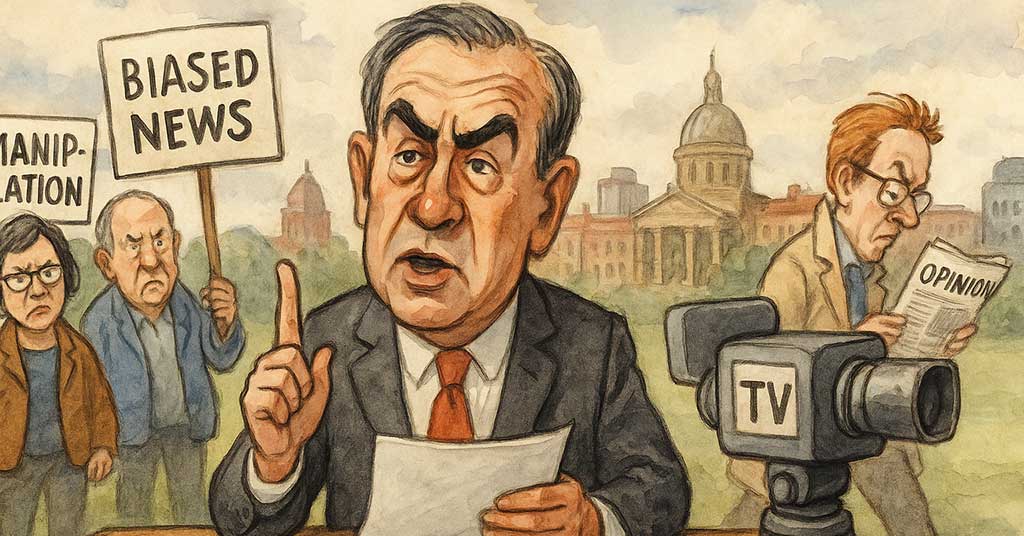Why Canadian news outlets have lost public trust
Once trusted for facts, Canadian news outlets now blur news and opinion, leaning on advocacy instead of balanced reporting

By Perry Kinkaide
News media in Canada have stopped being a source of facts. They have become a tool for shaping opinion. Once trusted for objectivity, they now tell audiences less about what happened and more about how they should think about it.
There was a time when Canadians could count on their daily news to deliver the who, what, where and when with restraint. Commentary was clearly separated from reporting. News was news. Views were views. The line was clear.
That line has blurred to the point of near invisibility. Television newscasts, digital platforms and online editions of once‑traditional papers now package facts with interpretation. A headline story doesn’t just report what occurred. It frames the meaning, signals what to believe and nudges viewers and readers toward the “right” conclusion.
The change didn’t happen overnight. As technology sped up the delivery of information, traditional reporting fell behind. By the time a paper landed on your doorstep or the evening news came on, the headlines were already old.
Social media made it worse, offering live updates from every corner of the world. Unable to compete on speed, news outlets sought relevance in another way.
Straight reporting no longer drew audiences, so opinion and advocacy took centre stage. What passes for analysis today is often one‑sided opinion dressed as reporting. Stories that once would have been factual were recast to deliver a verdict. Reporters didn’t just explain what happened: they told you what it meant, why it mattered and how you should think about it.
The collapse of the business model reinforced the shift. Advertising dollars that once funded Canadian newsrooms flowed instead to Google and Facebook. Classifieds, the lifeblood of local journalism, collapsed. Newsrooms shrank, and expensive investigative reporting was cut. Opinion was cheaper, faster and more shareable, so it filled the gap.
Between 2008 and 2021, more than 450 Canadian news outlets closed, according to the Local News Research Project, most of them community papers that had long provided local accountability.
In 2024, Metroland Media converted 71 Ontario community papers to online‑only publications, laying off more than 600 staff. In Atlantic Canada, SaltWire, now part of Postmedia, shed dozens of veteran journalists. Many towns and rural areas now have little to no independent reporting on local councils, school boards or courts.
Digital algorithms made the situation worse. Social media and news websites reward content that sparks clicks, comments and outrage—often sharp‑edged opinion rather than straightforward reporting. Broadcasters and online newsrooms adapted, producing content designed to provoke reactions instead of inform.
The result is a media landscape that often reads and sounds more like advocacy than journalism. An election story doesn’t just say what a leader promised. It casts judgment on whether the promise is credible, whether the candidate is trustworthy and what the audience should conclude. Judgments once confined to editorial pages and panels now run through entire news sections and broadcasts.
The same pattern plays out beyond politics. Business coverage pushes advocacy over reporting, especially on issues like pipelines, energy and the environment—issues that directly affect jobs and household costs. Cultural reporting is less about what happened and more about the moral lessons the journalist wants you to take from it.
Facts are the foundation of journalism. When they are replaced by opinion and spin, reporting stops being news and becomes persuasion. The duty to inform—the very reason news media exist—has been abandoned. Canadians aren’t given knowledge. They’re handed narratives.
The consequences are clear. Trust in the media is collapsing. A 2023 survey by the Reuters Institute found that less than half of Canadians trust most news, down sharply from a decade ago. Many now believe they are being sold perspective instead of information. Once credibility is gone, it is nearly impossible to win back.
The blunt truth is that much of today’s media no longer delivers what the name promises. It is less about facts than frames, less about events than agendas.
It is time to call it what it is. Today’s news is too often views, and Canadians should treat it as such.
That matters for more than journalism. When facts are replaced by spin and opinion, citizens are left with belief instead of knowledge.
A democracy cannot thrive when voters are fed narratives instead of truth. If the media do not deliver the news, Canadians will be left to make decisions in the dark.
Dr. Perry Kinkaide is a visionary leader and change agent. Since retiring in 2001, he has served as an advisor and director for various organizations and founded the Alberta Council of Technologies Society in 2005. Previously, he held leadership roles at KPMG Consulting and the Alberta Government. He holds a BA from Colgate University and an MSc and PhD in Brain Research from the University of Alberta.
The views, opinions and positions expressed by all Troy Media columnists and contributors are the author's alone. They do not inherently or expressly reflect the views, opinions and/or positions of Troy Media or White Rose Intelligence Inc.